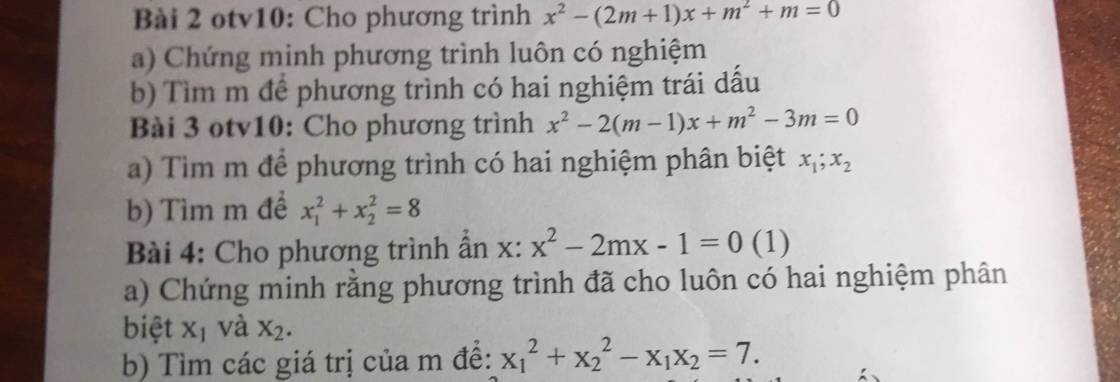Bài 4:
a: \(\text{Δ}=\left(-2m\right)^2-4\cdot1\cdot\left(-1\right)=4m^2+4>0\forall m\)
=>Phương trình (1) luôn có hai nghiệm phân biệt
b: Theo Vi-et, ta có:
\(\left\{{}\begin{matrix}x_1+x_2=-\dfrac{b}{a}=2m\\x_1x_2=\dfrac{c}{a}=-1\end{matrix}\right.\)
\(x_1^2+x_2^2-x_1x_2=7\)
=>\(\left(x_1+x_2\right)^2-3x_1x_2=7\)
=>\(\left(2m\right)^2-3\cdot\left(-1\right)=7\)
=>\(4m^2=4\)
=>\(m^2=1\)
=>\(\left[{}\begin{matrix}m=1\left(nhận\right)\\m=-1\left(nhận\right)\end{matrix}\right.\)
Bài 3:
a: \(\text{Δ}=\left[-2\left(m-1\right)\right]^2-4\left(m^2-3m\right)\)
\(=4m^2-8m+4-4m^2+12m=4m+4\)
Để phương trình có hai nghiệm phân biệt thì Δ>0
=>4m+4>0
=>m>-1
b: Theo Vi-et, ta có:
\(\left\{{}\begin{matrix}x_1+x_2=-\dfrac{b}{a}=2m-2\\x_1x_2=\dfrac{c}{a}=m^2-3m\end{matrix}\right.\)
\(x_1^2+x_2^2=8\)
=>\(\left(x_1+x_2\right)^2-2x_1x_2=8\)
=>\(\left(2m-2\right)^2-2\left(m^2-3m\right)=8\)
=>\(4m^2-8m+4-2m^2+6m-8=0\)
=>\(2m^2-2m-4=0\)
=>\(m^2-m-2=0\)
=>(m-2)(m+1)=0
=>\(\left[{}\begin{matrix}m=2\left(nhận\right)\\m=-1\left(loại\right)\end{matrix}\right.\)














